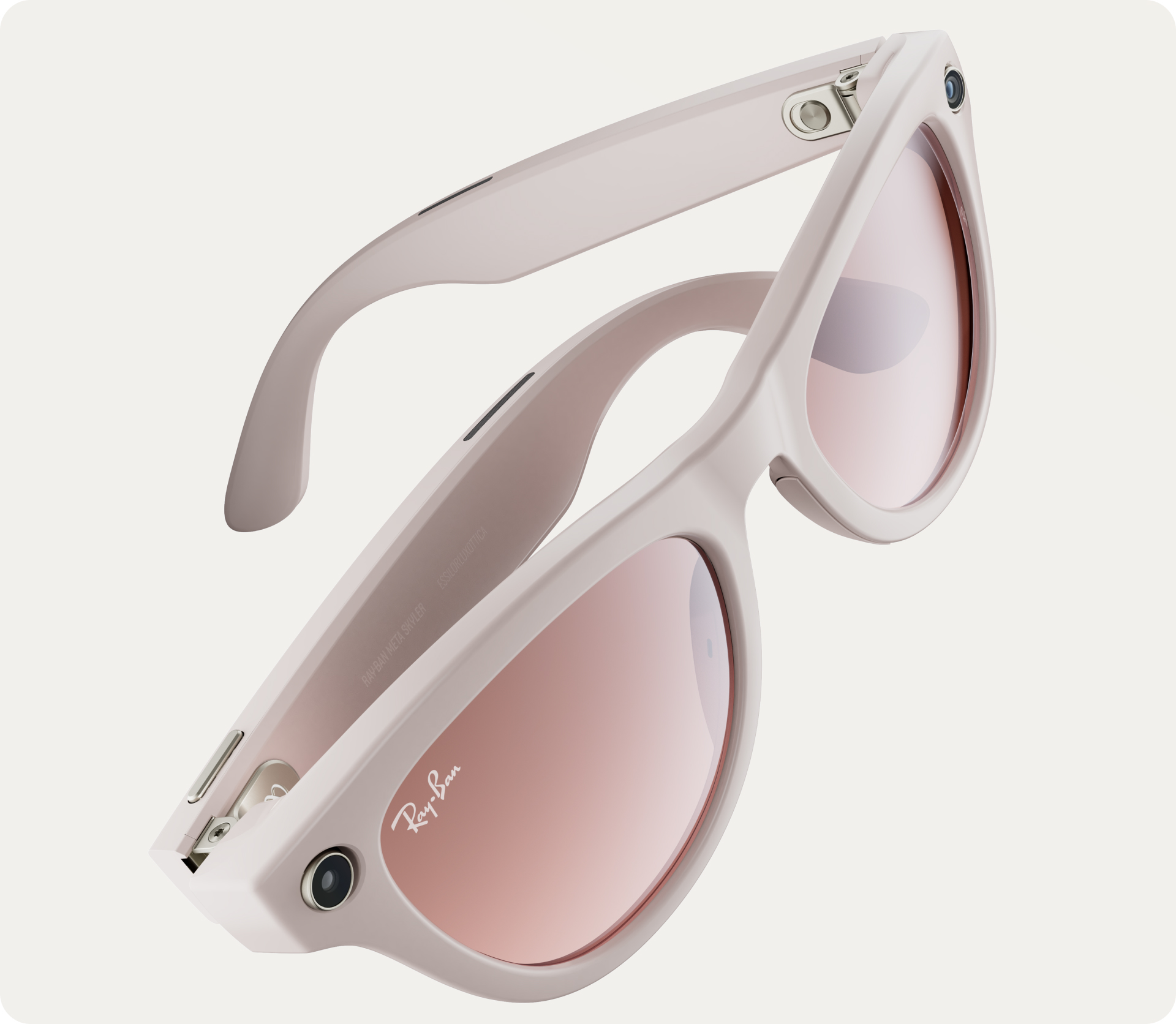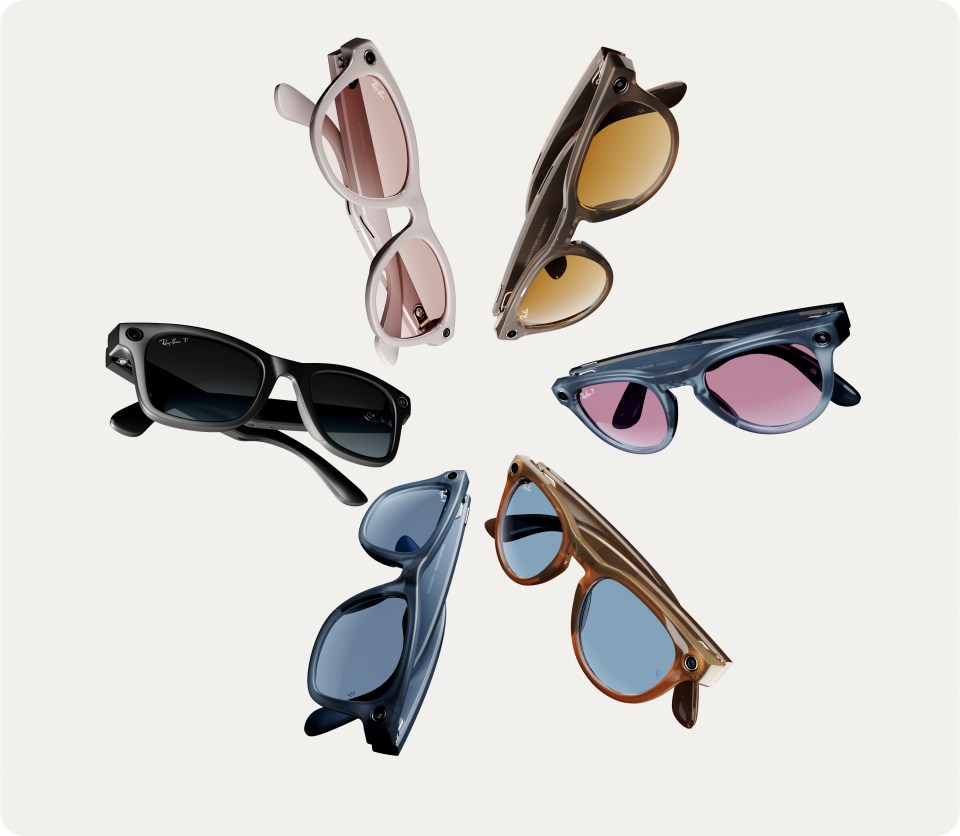
0:00 / 0:00
Back in 2019, the Orion team prepared an important demo for Meta Founder & CEO Mark Zuckerberg, showcasing potential waveguides for augmented reality glasses—a pivotal moment when theoretical calculations on paper were brought to life. And it was a demo that changed everything.
“Wearing the glasses with glass-based waveguides and multiple plates, it felt like you were in a disco,” recalls Optical Scientist Pasqual Rivera. “There were rainbows everywhere, and it was so distracting—you weren’t even looking at the AR content. Then, you put on the glasses with silicon carbide waveguides, and it was like you were at the symphony listening to a quiet, classical piece. You could actually pay attention to the full experience of what we were building. It was a total game changer.”
Yet as clear (pun intended) as the choice of silicon carbide as a substrate seems today, when we first started down the road to AR glasses a decade ago, it was anything but.

“Silicon carbide is normally heavily nitrogen-doped,” says Rivera. “It’s green, and if it gets thick enough, it looks black. There’s no way you could make an optical lens out of it. It’s an electronic material. There’s a reason it’s that color, and it’s because of electronic properties.”
“Silicon carbide has been around as a material for a long time,” agrees AR Waveguides Tech Lead Giuseppe Calafiore. “Its main application is high-power electronics. Take electric vehicles: All EVs require a chip—but that chip must also be capable of very high power, moving the wheels, and driving this thing. It turns out you can’t do it with the regular silicon substrate, which is what makes the chips that we use in our computers and electronics. You need a platform that allows you to go through high currents, high power, and that material is silicon carbide.”
Until fairly recent discussions around renewable energy sources started to heat up, the market for these high-power chipsets was nowhere near the size of the market for chips for consumer electronics. Silicon carbide has always been expensive, and there wasn’t much incentive to bring costs down because, for the size of chip that you make for a car, the price of the substrate was tolerable.
“But it turns out that silicon carbide also has some of the properties that we need for waveguides and optics,” Calafiore says. “The refractive index is the key property that we care about. And silicon carbide has a high refractive index, which means that it’s capable of channeling in and outputting a large quantity of optical data. You can think of it as optical bandwidth—just like you have bandwidth for the internet, and you want it to be large enough so that you can send huge amounts of data through that channel. The same goes for optical devices.”
The higher a material’s refractive index, the higher its étendue, so you can send more optical data through that channel.
“The channel in our case is our waveguide, and a larger étendue translates to a larger field of view,” explains Calafiore. “The larger the refractive index of a material, the larger field of view the display can support.”
The Road to the Right Refractive Index
When Calafiore first joined what was then Oculus Research in 2016, the highest refractive index glass the team had at its disposal was 1.8—which required stacking multiple plates to achieve the desired field of view. Undesirable optical artifacts aside, the assembly line became increasingly complicated as the first two waveguides had to be perfectly aligned, and then that stack had to be perfectly aligned with a third waveguide.
“Not only was it expensive, it was immediately obvious that you couldn’t have three pieces of glass per lens in a pair of glasses,” Calafiore recalls. “They were too heavy, and the thickness was prohibitively large and ugly—nobody would buy it. So we went back to square one: trying to boost the refractive index of the substrate to reduce the number of plates needed.”
The first material the team looked into was lithium niobate, which has a refractive index of roughly 2.3—quite a bit higher than the glass at 1.8.
“We realized that we only had to stack two plates and could maybe even manage with one plate to still cover the field of view,” says Calafiore. “Almost in parallel, we started looking at other materials—which is how we figured out alongside our suppliers in 2019 that silicon carbide, in its purest form, is actually very transparent. It also happens to have the highest refractive index known for an optical application, which is 2.7.”
That’s a 17.4% increase over lithium niobate and a 50% bump over glass, for those keeping score at home.
“With a few modifications to the very same equipment that was used in the industry already, it was possible to get transparent silicon carbide,” Calafiore says. “You could just change the process, be a lot more careful, and instead of optimizing for electronic properties, you optimize for optical properties: transparency, uniformity of the refractive index, etc.”
The Potential Cost of Compromise
At that time, the Reality Labs team was the first to even attempt moving from opaque silicon carbide wafers to transparent ones. And because silicon carbide is one of the hardest known materials, it essentially requires diamond tooling to cut or polish it. As a result, the non-recurring engineering costs were very high, so the resulting substrate was quite expensive.
While more cost-effective alternatives exist, as with any technology, they each have tradeoffs. And as the field of view increases towards Orion’s industry-leading field of view of approximately 70 degrees, new issues arise like ghost images and rainbows.
“Finding the optimum solution for a wide field of view AR display is fraught with tradeoffs between performance and costs,” explains Director of Research Science Barry Silverstein. “Costs can often be driven down, but if performance doesn’t cut it, costs won’t ultimately matter.”
Ghost images are like visual echoes of the primary image being projected onto the display. Rainbows are colorful streaks of light that are created when ambient light reflects off of the waveguide. “Say you’re driving at night with moving car lights around you,” says Silverstein. “You’re going to have rainbows that move, too. Or if you’re out on the beach playing volleyball and the sun’s shining, you’re going to get a rainbow streak that’s moving with you and you’ll miss your shot. And one of the miraculous properties of silicon carbide is that it gets rid of those rainbows.”
“The other advantage of silicon carbide that none of the other materials have is thermal conductivity,” Calafiore adds. “Plastic is a terrible insulator. Glass, lithium niobate, same thing. You go to silicon carbide and it’s transparent, looks like glass, and guess what: It conducts heat.”
So in July 2020, the team determined that silicon carbide was the optimum choice for three primary reasons: It led to an improved form factor because it required only a single plate and smaller mounting structures, it had better optical properties, and it was lighter than dual-plate glass.

The Secret of Slant Etch
With the material in mind, the next nut to crack was the fabrication of the waveguides—and specifically, an unconventional grating technique called slant etch.
“The grating is the nanostructure that in-couples and out-couples the light from the lens,” explains Calafiore. “And for silicon carbide to work, the grating needs to be slant etch. Instead of being vertical, you want the lines of the grating to be sloped diagonally.”
“We were the first ones to do slant etch directly on the devices,” says Research Manager Nihar Mohanty. “The whole industry used to rely on nano imprint, which doesn’t work for substrates with such a high refractive index. That’s why no one else in the world had thought about doing silicon carbide.”
But because slant etch is an immature technology, most semiconductor chip suppliers and factories lack the necessary tools.
“Back in 2019, my manager at the time, Matt Colburn, and I established our own facility as there was nothing in the world that could produce etched silicon carbide waveguides and where we could prove out the technology beyond the labscale,” explains Mohanty. “It was a huge investment, and we established the whole pipeline there. The tooling was custom-made for us by our partners, and the process was developed in-house in Meta, though our systems are research-grade because there were no manufacturing-grade systems out there. We worked with a manufacturing partner to develop manufacturing-grade slant etch tooling and processes. And now that we’ve shown what’s possible with silicon carbide, we want others in the industry to start making tools of their own.”
The more companies that invest in optical-grade silicon carbide and develop equipment, the stronger the category of consumer AR glasses will become.
No Longer Chasing Rainbows
While technological inevitability is a myth, the stars certainly seem to be aligning in silicon carbide’s favor. And although the team continues to investigate alternatives, there’s a strong sense that the right people have come together at the right time under the right market conditions to build AR glasses using this material.
“Orion proved that silicon carbide is a viable option for AR glasses,” says Silverstein, “and we’re now seeing interest across the supply chain on three different continents where they’re heavily pursuing this as an opportunity. Silicon carbide will come out on top. It’s just a matter of time in my book.”
And a lot can happen in that time—much like the way the tables have turned since we grew our first clear silicon carbide crystals.
“All of these silicon carbide manufacturers had cranked up the supply massively in response to the expected EV boom,” notes Calafiore. “Right now, there’s an overcapacity that didn’t exist when we were building Orion. So now, because supply is high and demand is low, the cost of the substrate has started to come down.”
“Suppliers are very excited by the new opportunity of manufacturing optical-grade silicon carbide—after all, each waveguide lens represents a large amount of material relative to an electronic chip, and all of their existing capabilities apply to this new space,” adds Silverstein. “Filling your factory is essential, and scaling your factory is the dream. The size of the wafer matters, too: The bigger the wafer, the lower the cost—but the complexity of the process also goes up. That said, we’ve seen suppliers move from four-inch to eight-inch wafers, and some are working on precursors to 12-inch wafers, which would yield exponentially more pairs of AR glasses.”
These advancements should help continue to drive costs down. It’s still early days, but the future is coming into focus.
“At the beginning of any new technological revolution, you try a bunch of things,” says Calafiore. “Look at television: We started with cathode-ray tubes, and then we went to the LED plasma TVs and now microLEDs. We went through several different technologies and architectures. As you pathfind, lots of paths end up nowhere, but there are some that you just keep coming back to as the most promising. We’re not at the end of the road, and we can’t do it alone, but silicon carbide is a wonder material that is well worth the investment.”
“The world is awake now,” adds Silverstein. “We’ve successfully shown that silicon carbide can flex across electronics and photonics. It’s a material that could have future applications in quantum computing. And we’re seeing signs that it’s possible to significantly reduce the cost. There’s a lot of work left to be done, but the potential upside here is huge.”
Learn more about silicon carbide in Photonics Spectra.
Για περισσότερες πληροφορίες σχετικά με τον Orion, ανατρέξτε σε αυτές τις αναρτήσεις ιστολογίου:


































